Effect of Aggregate and Binder Type on the Functional and Durability Parameters of Lightweight Repair Mortars
Abstract
:1. Introduction
2. Materials and Methods
2.1. Materials
2.2. Chemical Composition and Phase Analysis of Initial Materials
2.3. Physical Properties of Ligweight Aggregates
2.4. Assessment of Pozzolanic Activity of the Applied Aggregates
2.5. Particle Size Distribution Analysis
2.6. Microstructure of Aggregates
2.7. Sample Preparation and Curing
2.8. Testing of Hardened Mortars
3. Results and Discussion
3.1. Structural Parameters
3.2. Mechanical Parameters
3.3. Hygric Properties
3.4. Heat Transport and Storage Properties
3.5. Salt Crystallization Resistance
3.6. Sorption Isotherms
4. Conclusions
- (i)
- Application of lightweight aggregates enabled the development of highly porous and low-density materials meeting the requirements imposed on repair mortars.
- (ii)
- With respect to mechanical performance, the lime and natural hydraulic lime-based mortars were found applicable for repair purposes even in historical masonry, where compatibility and functional criteria must be always attentively considered. Lime–cement mortars were too rigid and dense for such purposes.
- (iii)
- Lime and natural hydraulic lime mortars were well permeable for water vapor and the use of lightweight aggregate even accelerated water vapor transport. These materials are therefore proper for application in damp masonry, where they can ensure drying of the contained water and thus improve the overall hygrothermal performance of the treated structure. As lime–cement mortar with expanded perlite met the requirements for water vapor resistance factor introduced in WTA directive 2-9-04/D, the lightweight lime–cement materials can be recommended for repair of masonry built with cement–lime mortar as well in the construction of new buildings.
- (iv)
- For the lightweight mortars, water absorption was greatly increased, and based on the water absorption coefficient values, these can be classified as repair mortars applicable in the repair of damp buildings.
- (v)
- The use of EP and EG resulted in the great improvement of thermal conductivity. Mortars with these types of aggregate were therefore ranked among thermal insulation mortars in class T1 or T2, respectively.
- (vi)
- Independently of the binder type, all lightweight mortars have shown excellent resistance against salt crystallization, which is favorable for their presumed use in repair and restoration works.
- (vii)
- The water vapor adsorption capacity of the reference mortars was enhanced by two effects: (a) incorporation of lightweight aggregates (the highest hygroscopicity was measured for zeolite-modified mortars), and (b) presence of NaCl and Na2SO4. The effect of salination on the overall water vapor adsorption rate and the hygrothermal function of materials must always be considered, especially when repairing older buildings, where salts can be present and originate from several sources.
Author Contributions
Funding
Institutional Review Board Statement
Informed Consent Statement
Data Availability Statement
Conflicts of Interest
References
- Commission Recommendation (EU) 2019/786 of 8 May 2019 on Building Renovation. Available online: https://eur-lex.europa.eu/eli/reco/2019/786/oj (accessed on 17 June 2021).
- Communication from the Commission to the European Parliament, the Council, the European Economic and Social Committee and the Committee of the Regions—A Renovation Wave for Europe. 2020. Available online: https://eur-lex.europa.eu/legal-content/EN/TXT/?qid=1603122220757&uri=CELEX:52020DC0662 (accessed on 17 June 2021).
- Sulakatko, V.; Liisma, E.; Soekov, E. Increasing construction quality of external thermal insulation composite system (ETICS) by revealing on-site degradation factors. Procedia Environ. Sci. 2017, 38, 765–772. [Google Scholar] [CrossRef]
- Záleská, M.; Pavlíková, M.; Pivák, S.A.; Lauermannová, A.M.; Jankovský, O.; Pavlík, Z. Lightweight vapor-permeable plasters for building repair: Detailed experimental analysis of the functional properties. Materials 2021, 14, 2613. [Google Scholar] [CrossRef]
- Barbero, S.; Dutto, M.; Ferrua, C.; Pereno, A. Analysis of existent thermal insulating plasters towards innovative applications: Evaluation methodology for real cost-performance comparison. Energy Build. 2014, 77, 40–47. [Google Scholar] [CrossRef] [Green Version]
- Arizzi, A.; Viles, H.; Cultrone, G. Experimental testing of the durability of lime-based mortars used for rendering historic buildings. Constr. Build. Mater. 2012, 28, 807–818. [Google Scholar] [CrossRef]
- Vyšvařil, M.; Pavlíková, M.; Záleská, M.; Pivák, A.; Žižlavský, T.; Rovnaníková, P.; Bayer, P.; Pavlík, Z. Non-hydrophobized perlite renders for repair and thermal insulation purposes: Influence of different binders on their properties and durability. Constr. Build. Mater. 2020, 263, 120617. [Google Scholar] [CrossRef]
- Barbero-Barrera, M.M.; Maldonado-Ramos, L.; Van Balen, K.; García-Santos, A.; Neila-Gonzáles, F.J. Lime render layers: An overview of their properties. J. Cult. Herit. 2014, 15, 326–330. [Google Scholar] [CrossRef]
- Bozkurt, T.S.; Demirkale, S.Y. The experimental research of sound absorption in plasters produced with perlite aggregate and natural hydraulic lime binder. Acoust. Aust. 2020, 48, 375–393. [Google Scholar] [CrossRef]
- Aškrabič, M.; Vyšvařil, M.; Zakić, D.; Savić, A.; Stevanović, B. Effects of natural zeolite addition on the properties of lime putty-based rendering mortars. Constr. Build. Mater. 2021, 270, 121363. [Google Scholar] [CrossRef]
- Pacheco-Torgal, F.; Faria, J.; Jalali, S. Some considerations about the use of lime-cement mortars for building conservation purposes in Portugal: A reprehensible option or a lesser evil? Constr. Build. Mater. 2012, 30, 488–494. [Google Scholar] [CrossRef] [Green Version]
- European Committee for Standardization (CEN). Specification for Mortar for Masonry—Part 1: Rendering and Plastering Mortar; EN 998-1; European Committee for Standardization (CEN): Brussels, Belgium, 2016. [Google Scholar]
- WTA. Wissenschaftlich-Technische Arbeitsgemeinschaft für Bauwerkserhaltung und Denkmalpflege e.V. In Sanierputzsysteme; Merkblatt 2-9-04/D; WTA Publications: Pfaffenhofen an der Ilm, Germany, 2005. [Google Scholar]
- Ashour, T.; Wieland, H.; Georg, H.; Bockisch, F.-J.; Wu, W. The influence of natural reinforcement fibres on insulation values of earth plaster for straw bale buildings. Mater. Design. 2010, 31, 4676–4685. [Google Scholar] [CrossRef]
- Ismail, B.; Belayachi, N.; Hoxha, D. Optimizing performance of insulation materials based on wheat straw, lime and gypsum plaster composites using natural additives. Constr. Build. Mater. 2020, 254, 118959. [Google Scholar] [CrossRef]
- Gencel, O.; del Coz Diaz, J.J.; Sutcu, M.; Koksal, F.; Rabanal, F.P.A.; Martínez-Barrera, G. A novel lightweight gypsum composite with diatomite and polypropylene fibers. Constr. Build. Mater. 2016, 113, 732–740. [Google Scholar] [CrossRef]
- Corinaldesi, V.; Donnini, J.; Nardinocchi, A. Lightweight plasters containing plastic waste for sustainable and energy-efficient building. Constr. Build. Mater. 2015, 94, 337–345. [Google Scholar] [CrossRef]
- Styzeń, J.; Barnat-Hunek, D.; Panek, R.; Franus, W. The microstructural and physical properties of renovation renders with clinoptilolite, Na-P1 and Na-X zeolites. Constr. Build. Mater. 2020, 261, 120016. [Google Scholar] [CrossRef]
- Petrella, A.; Di Mundo, R.; De Gisi, S.; Todaro, F.; Labianca, C.; Notarnicola, M. Environmentally Sustainable Cement Composites Based on End-of-Life Tyre Rubber and Recycled Waste Porous Glass. Materials 2019, 12, 3289. [Google Scholar] [CrossRef] [Green Version]
- Buratti, C.; Moretti, E.; Belloni, E.; Agosti, F. Development of Innovative Aerogel Based Plasters: Preliminary Thermal and Acoustic Performance Evaluation. Sustainability 2014, 6, 5839–5852. [Google Scholar] [CrossRef] [Green Version]
- Nosrati, R.H.; Berardi, U. Hygrothermal characteristics of aerogel-enhanced insulating materials under different humidity and temperature conditions. Energy Build. 2018, 158, 698–711. [Google Scholar] [CrossRef]
- Fenoglio, E.; Fantucci, S.; Serra, V.; Carbonaro, C.; Pollo, R. Hygrothermal and environmental performance of a perlite-based insulating plaster for the energy retrofit of buildings. Energy Build. 2018, 179, 26–38. [Google Scholar] [CrossRef]
- Pavlíková, M.; Kapicová, A.; Pivák, A.; Záleská, M.; Lojka, M.; Jankovský, O.; Pavlík, Z. Zeolite lightened repair renders: Effect of binder type on properties and salt crystallization resistance. Materials 2021, 14, 3760. [Google Scholar] [CrossRef]
- Lubelli, B.; de Rooij, M.R. NaCl crystallization in restoration plasters. Constr. Build. Mater. 2009, 23, 1736–1742. [Google Scholar] [CrossRef]
- Brachaczek, W. Microstructure of renovation plasters and their resistance to salt. Constr. Build. Mater. 2018, 182, 418–426. [Google Scholar] [CrossRef]
- Barnat-Hunek, D.; Frańczak, M.G.; Klimek, B.; Pavlíková, M.; Pavlík, Z. Properties of multi-layer renders with fly ash and boiler slag admixtures for salt-laden masonry. Constr. Build. Mater. 2021, 278, 122366. [Google Scholar] [CrossRef]
- Pavlík, Z.; Pokorný, J.; Pavlíková, M.; Zemanová, L.; Záleská, M.; Vyšvařil, M.; Žižlavský, T. Mortars with Crushed Lava Granulate for Repair of Damp Historical Buildings. Materials 2019, 12, 3557. [Google Scholar] [CrossRef]
- Association Francaise de Normalisation (AFNOR). Pozzolanic Addition for Concrete—Metakaolin—Definitions, Specifications and Conformity; NF P 18-513; Association Francaise de Normalisation (AFNOR): La Plaine Saint-Denis, France, 2010. [Google Scholar]
- Raverdy, M.; Brivot, F.; Paillére, A.M.; Dron, R. Appréciation de I’Activité Pouzzolanique des Constituents Secondaires. In Proceedings of the 7th International Congress on the Chemistry of Cement, Paris, France, 30 June–4 July 1980; Éditions Septima: Paris, France, 1980; Volume 3, pp. 36–41. [Google Scholar]
- Committee for Standardization (CEN). Methods of Test for Mortar for Masonry—Part 3: Determination of Consistence of Fresh Mortar (by Flow Table); EN 1015-3; European Committee for Standardization (CEN): Brussels, Belgium, 1999. [Google Scholar]
- Committee for Standardization (CEN). Methods of Test for Mortar for Masonry—Part 10: Determination of Dry Bulk Density of Hardened Mortar; EN 1015-10; European Committee for Standardization (CEN): Brussels, Belgium, 1999. [Google Scholar]
- Záleská, M.; Pavlík, Z.; Čítek, D.; Jankovský, O.; Pavlíková, M. Eco-friendly concrete with scrap-tyre-rubber-based aggregate—Properties and thermal stability. Constr. Build. Mater. 2019, 225, 709–722. [Google Scholar] [CrossRef]
- European Committee for Standardization (CEN). Methods of Test for Mortar for Masonry—Part 11: Determination of Flexural and Compressive Strength of Hardened Mortar; EN 1015-11; European Committee for Standardization (CEN): Brussels, Belgium, 1999. [Google Scholar]
- European Committee for Standardization (CEN). Methods of Test for Mortar for Masonry—Part 18: Determination of Water Absorption Coefficient Due to Capillarity Action of Hardened Mortar; EN 1015-18; European Committee for Standardization (CEN): Brussels, Belgium, 2002. [Google Scholar]
- Kumaran, M. Moisture diffusivity of building materials from water absorption measurements. J. Therm. Envel. Build. Sci. 1999, 22, 349–355. [Google Scholar] [CrossRef]
- International Organization for Standardization (ISO). Hygrothermal Performance of Building Materials and Product Determination of Water Vapour Transmission Properties; EN ISO 12572; International Organization for Standardization (ISO): Geneva, Switzerland, 2016. [Google Scholar]
- Pavlík, Z.; Trník, A.; Keppert, M.; Pavlíková, M.; Žumár, J.; Černý, R. Experimental investigation of the Properties of lime-based plaster-containing PCM for enhancing the heat-storage capacity of building envelopes. Int. J. Thermophys. 2014, 35, 767–782. [Google Scholar] [CrossRef]
- European Committee for Standardization (CEN). Nature Stone Test Methods—Determination of Resistance to Salt Crystallization; EN 12370; European Committee for Standardization (CEN): Brussels, Belgium, 2020. [Google Scholar]
- Committee for Standardization (CEN). Hygrothermal Performance of Building Materials and Products—Determination of Hygroscopic Sorption Properties; ISO 12571; European Committee for Standardization (CEN): Brussels, Belgium, 2013. [Google Scholar]
- Silva, B.A.; Ferreira Pinto, A.P.; Gomes, A. Natural hydraulic lime versus cement for blended lime mortars for restoration works. Constr. Build. Mater. 2015, 94, 346–360. [Google Scholar] [CrossRef]
- Faria-Rodrigues, P.; Henriques, F.M.A. Current mortars in conservation: An overview. Restor. Build. Monum. 2004, 10, 609–622. [Google Scholar] [CrossRef]
- Fusade, L.; Viles, H.; Wood, C.; Burns, C. The effect of wood ash on the properties and durability of lime mortar for repointing damp historical buildings. Constr. Build. Mater. 2019, 212, 500–513. [Google Scholar] [CrossRef]
- da Fonseca, B.S.; Pinto, A.P.F.; Silva, D.V. Compositional and textural characterization of historical bedding mortars from rubble stone masonries: Contribution for the design of compatible repair mortars. Constr. Build. Mater. 2020, 247, 1186277. [Google Scholar] [CrossRef]
- Forster, A.M. Building conservation philosophy for masonry repair part 2—‘principles’. Struct. Surv. 2010, 28, 165–188. [Google Scholar] [CrossRef]
- Maurenbrecher, P. RILEM TC 203-RHM Repair mortars for historic masonry. Requirements for repointing mortars for historic masonry. Mater. Struct. 2012, 45, 1295–1302. [Google Scholar] [CrossRef]
- Hughes, J.J. ILEM TC 203-RHM Repair mortars for historic masonry, The role of mortar in masonry an introduction to requirements for the design of repair mortars. Mater. Struct. 2012, 45, 1287–1294. [Google Scholar] [CrossRef]
- Nogueira, R.; Pinto, A.P.F.; Gomes, A. Design and behavior of traditional lime-based plasters and renders. Review and critical appraisal of strengths and weaknesses. Cem. Concr. Compos. 2018, 89, 192–204. [Google Scholar] [CrossRef]
- Veiga, M.; Aguiar, J.; Silva, A.S.; Carvalho, S.F. Methodologies for characterisation and repair of mortars of ancient buildings. In Historical Constructions; Lourenço, P., Roca, P., Eds.; University of Minho: Guimarães, Portugal, 2001. [Google Scholar]
- Papayianni, I. The longevity of old mortars. Appl. Phys. A 2006, 83, 685–688. [Google Scholar] [CrossRef]
- Torres, I.; Matias, G.; Faria, P. Natural hydraulic lime mortars—The effect of ceramic residues on physical and mechanical behavior. J. Build. Eng. 2020, 32, 101747. [Google Scholar] [CrossRef]
- Garijo, L.; Zhang, X.; Ruiz, G.; Ortega, J.J. Age effect on the mechanical properties of natural hydraulic and aerial lime mortars. Constr. Build. Mater. 2020, 236, 117573. [Google Scholar] [CrossRef]
- Grilo, J.; Faria, P.; Veiga, R.; Silva, A.S.; Silva, V.; Velosa, A. New natural hydraulic lime mortars. Physical and microstructural properties in different curing conditions. Construct. Build. Mater. 2014, 54, 378–384. [Google Scholar] [CrossRef] [Green Version]
- Pavlíková, M.; Zemanová, L.; Záleská, M.; Pokorný, J.; Lojka, M.; Jankovský, O.; Pavlík, Z. Ternary blended binder for production of a novel type of lightweight repair mortar. Materials 2019, 12, 996. [Google Scholar] [CrossRef] [Green Version]
- Hens, H.S. The vapor diffusion resistance and air permeance of masonry and roofing systems. Build. Environ. 2006, 41, 745–755. [Google Scholar] [CrossRef]
- Silva, B.A.; Pinto, A.F.; Gomes, A.; Candeias, A. Comparative analysis of the behaviour of integral water-repellents on lime mortars. Constr. Build. Mater. 2020, 261, 120344. [Google Scholar] [CrossRef]
- González-Sánchez, J.F.; Fernández, J.M.; Navarro-Blasco, Í.; Alvarez, J.I. Improving lime-based rendering mortars with admixtures. Constr. Build. Mater. 2021, 271, 121887. [Google Scholar] [CrossRef]
- Barnat-Hunek, D.; Siddique, R.; Łagód, G. Properties of hydrophobized lighweight mortars with expanded cork. Constr. Built. Mater. 2017, 155, 15–25. [Google Scholar] [CrossRef]
- Torres, I.; Matias, G. Sustainable mortars for rehabilitation of old plasters. Eng. Struct. 2016, 129, 11–17. [Google Scholar] [CrossRef]
- Dong, X.; Wang, S.; Gong, C.; Lu, L. Effects of aggregate gradation and polymer modifiers on properties of cement-EPS/vitrified microsphere mortar. Constr. Build. Mater. 2014, 73, 255–260. [Google Scholar] [CrossRef]
- Jiang, D.; Lv, S.; Cui, S.; Sun, S.; Song, X.; He, S.; Zhang, J.; An, P. Effect of thermal insulation components on physical and mechanical properties of plant fibre composite thermal insulation mortar. J. Mater. Res. Technol. 2020, 9, 12996–13013. [Google Scholar] [CrossRef]
- Bai, L.; Xie, J.; Liu, J.; Xie, Y. Effect of salt on hygroscopic properties of cement mortar. Constr. Build. Mater. 2021, 305, 124746. [Google Scholar] [CrossRef]
- Darr, J.P.; Davis, S.Q.; Kohno, Y.; McKenna, K.; Morales, P. Morphological effects on the hygroscopic properties of sodium chloride–sodium sulfate aerosols. J. Aerosol Sci. 2014, 77, 158–167. [Google Scholar] [CrossRef]
- Martin, S.T. Phase transitions of aqueous atmospheric particles. Chem. Rev. 2000, 100, 3403–3453. [Google Scholar] [CrossRef]
- Biskos, G.; Malinowski, A.; Russll, L.M.; Busseck, P.R.; Martin, S.T. Nanosize effect on the deliquescence and the efflorescence of sodium chloride particles. Aerosol Sci. Technol. 2006, 40, 97–106. [Google Scholar] [CrossRef] [Green Version]
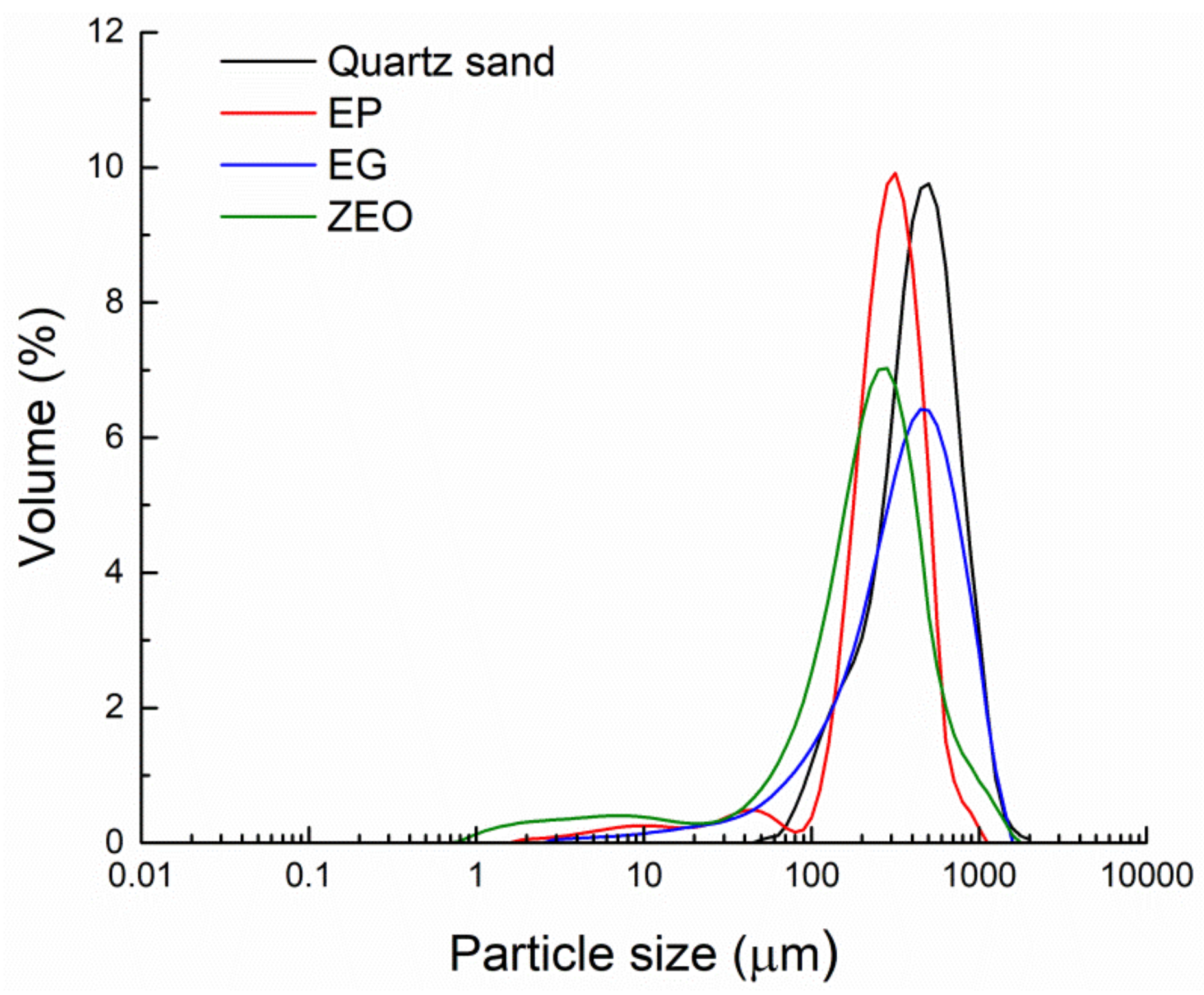
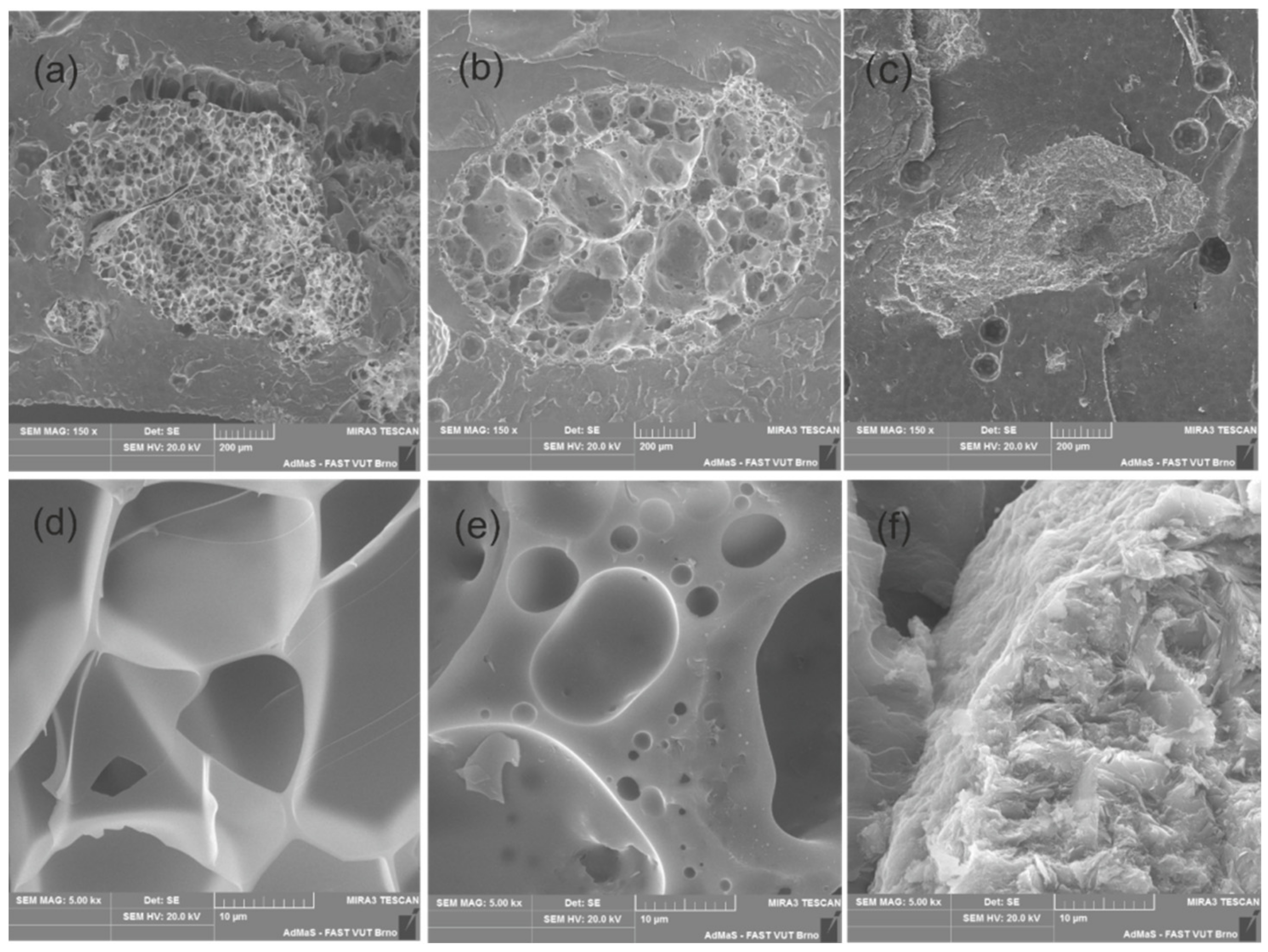
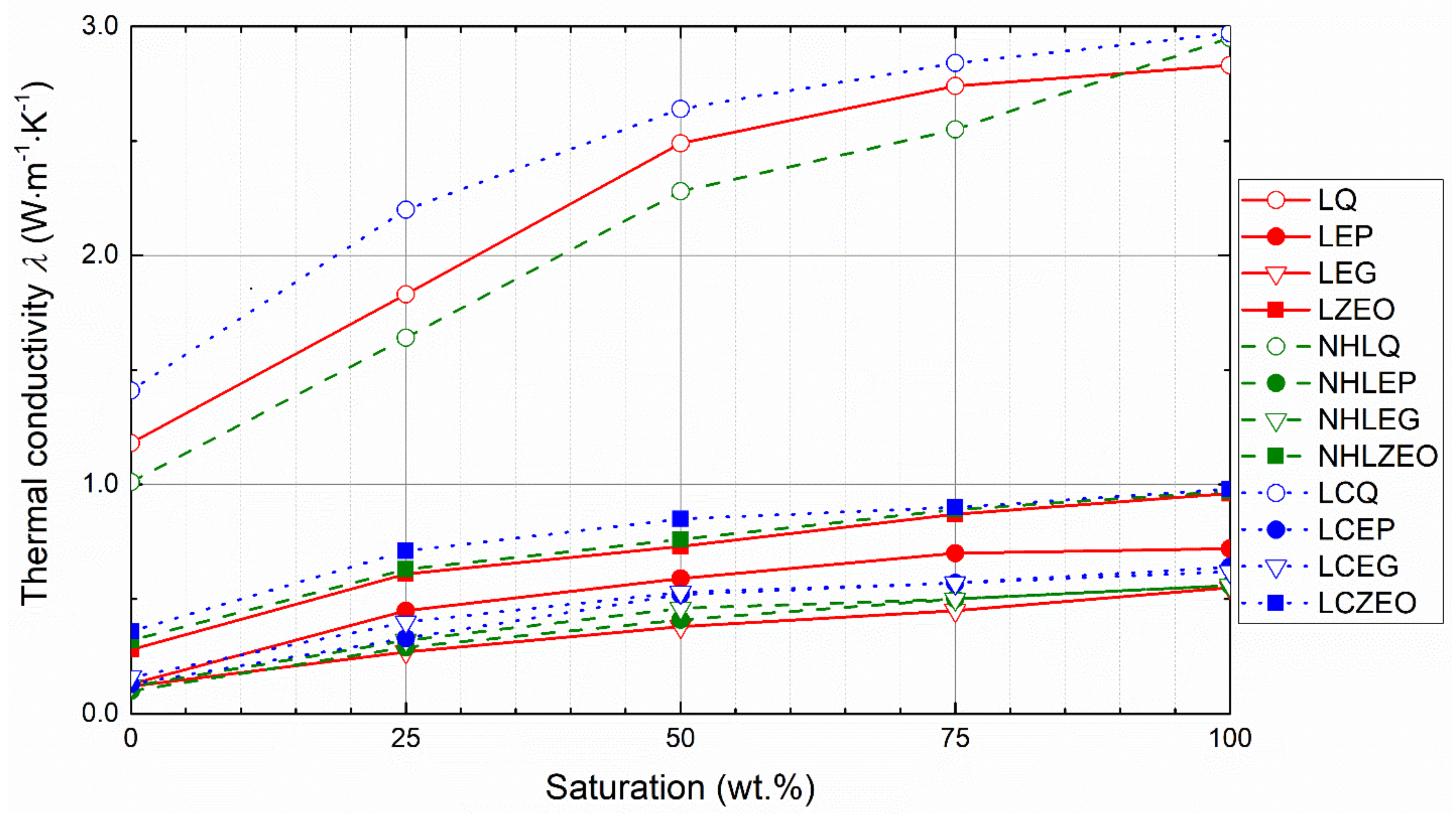
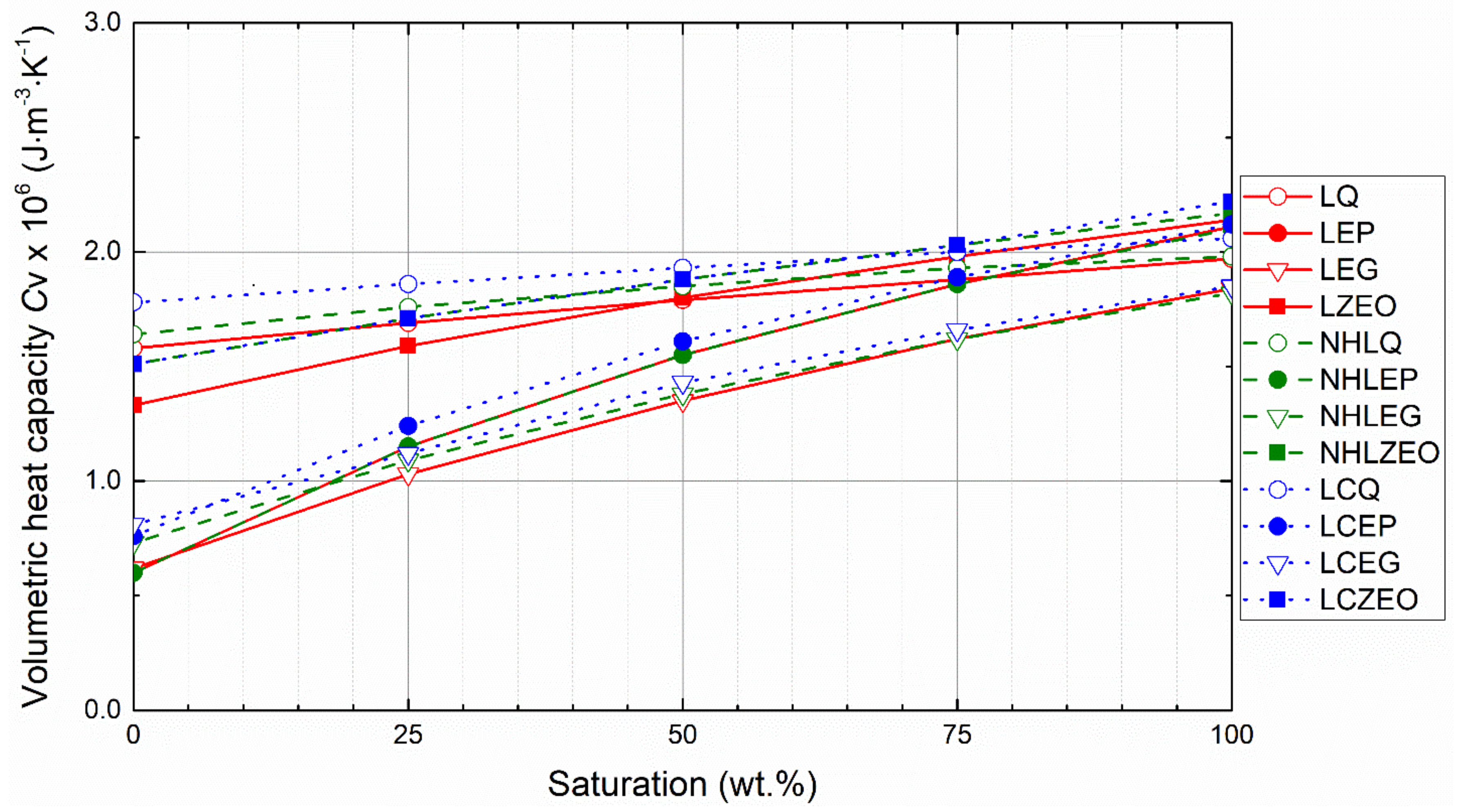
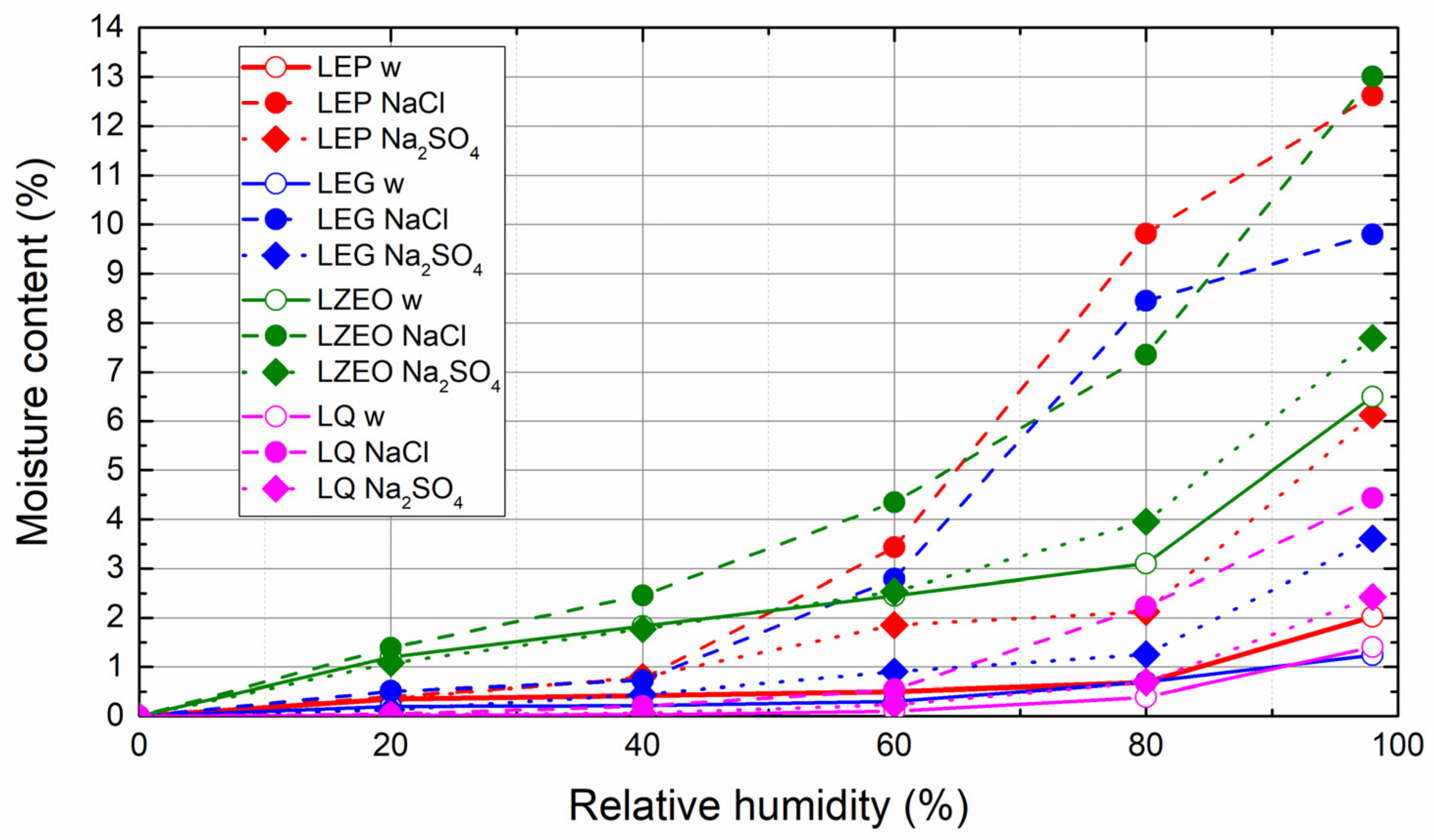
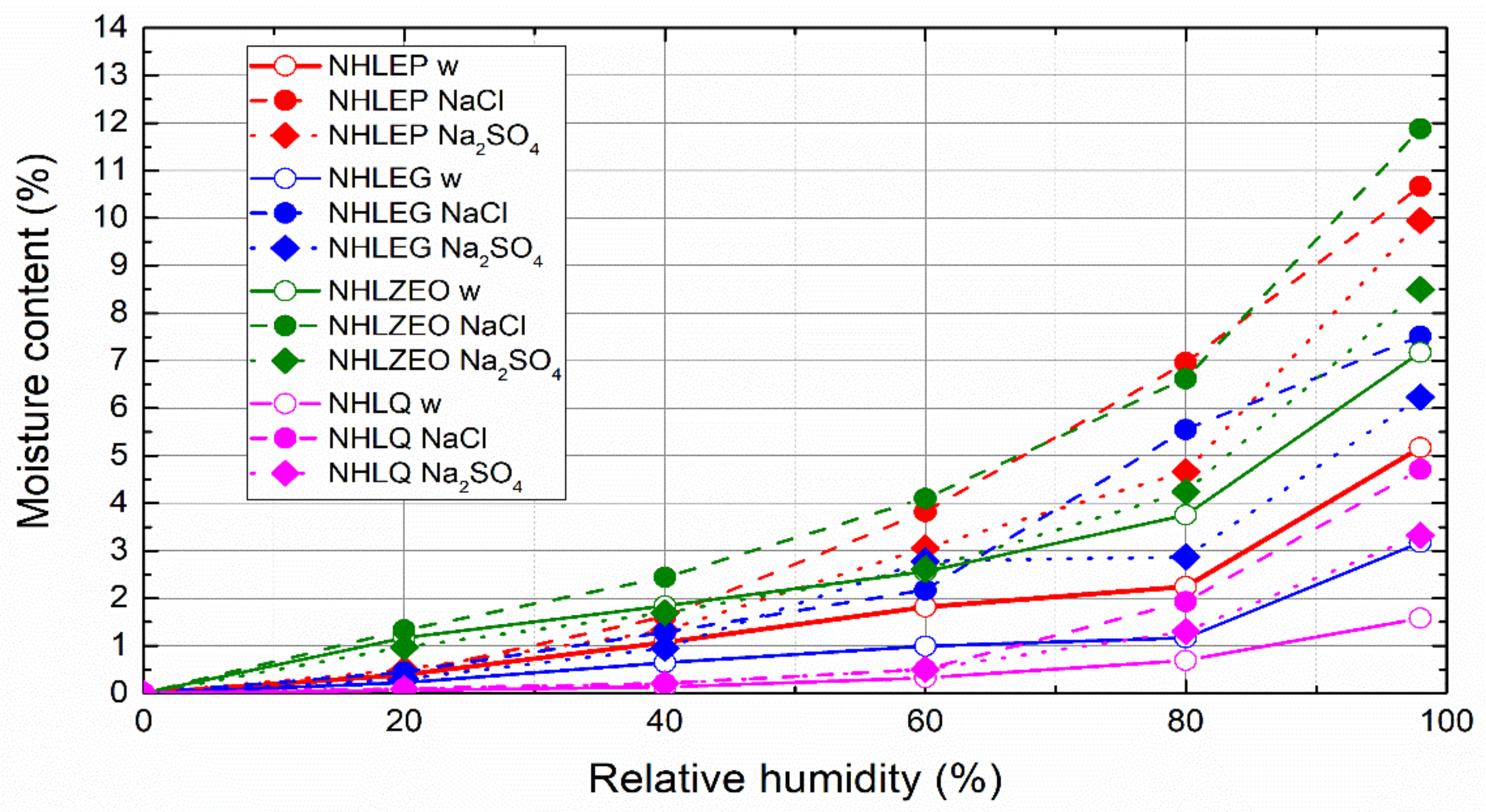
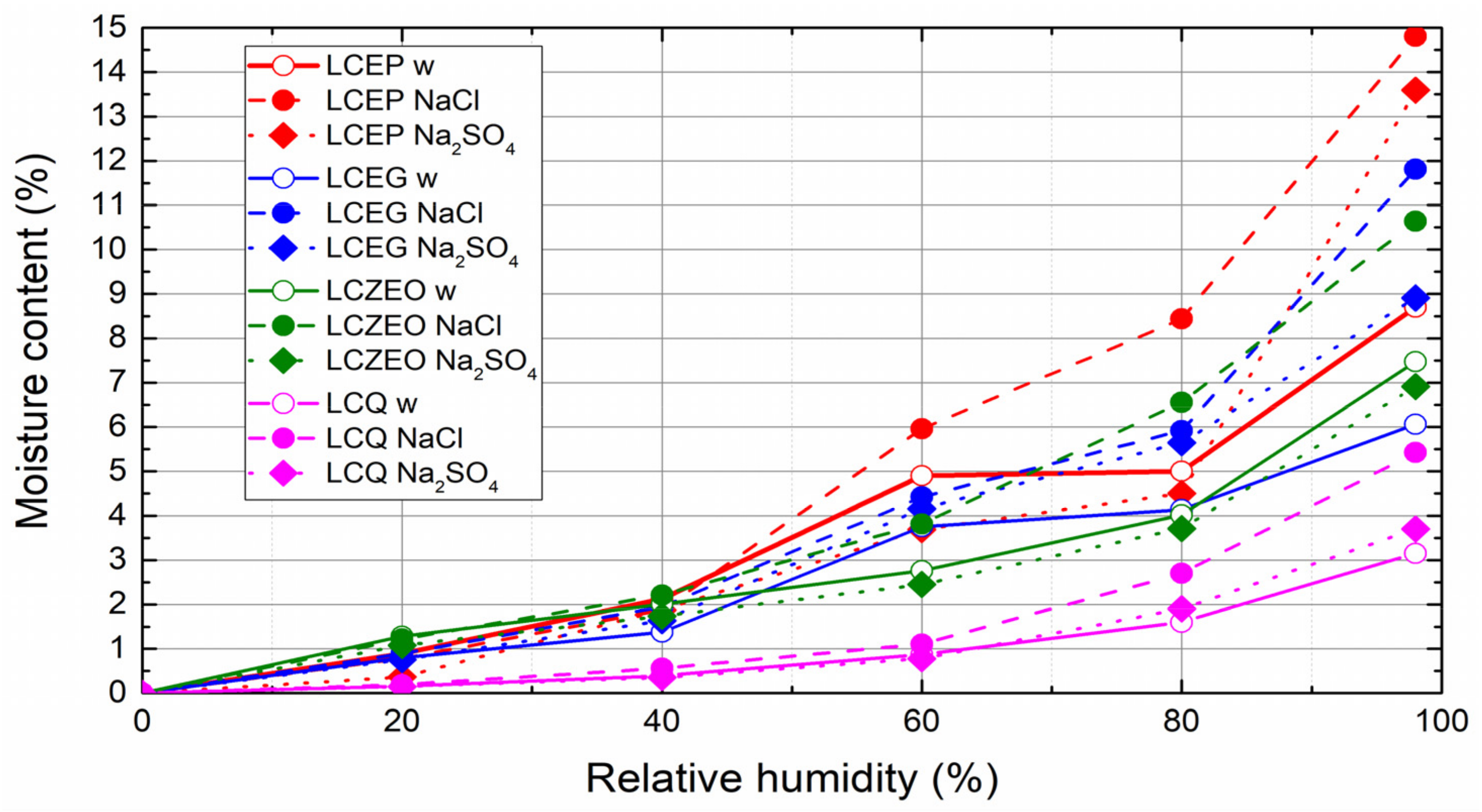
| SiO2 | Al2O3 | Fe2O3 | CaO | MgO | K2O | Na2O | P2O5 | TiO2 | SO3 | LOI 1 | |
|---|---|---|---|---|---|---|---|---|---|---|---|
| Lime | 0.92 | 0.71 | 0.39 | 68.09 | 1.33 | 0.48 | 0.11 | 0.05 | 0.10 | 0.19 | 27.94 |
| NHL 3.5 | 12.76 | 4.12 | 1.47 | 59.87 | 2.79 | 1.13 | 0.09 | 0.15 | 0.05 | 0.15 | 15.28 |
| Cement | 21.26 | 5.08 | 3.64 | 61.48 | 0.86 | 0.91 | 0.12 | 0.08 | 0.29 | 2.42 | 4.17 |
| Quartz sand | 98.50 | 0.38 | 0.15 | 0.01 | 0.03 | 0.09 | 0.01 | 0.04 | 0.09 | 0.02 | 0.12 |
| EP | 68.02 | 16.04 | 1.91 | 4.54 | 0.41 | 2.50 | 4.62 | 0.14 | 0.10 | 0.02 | 0.33 |
| EG | 70.27 | 2.16 | 0.49 | 9.43 | 2.11 | 0.84 | 13.82 | 0.12 | 0.18 | 0.21 | 0.13 |
| ZEO | 67.46 | 11.73 | 1.37 | 2.84 | 0.73 | 3.02 | 0.50 | 0.03 | 0.17 | 0.01 | 11.57 |
| Mineral | Lime | NHL 3.5 | Cement | Quartz Sand | EP | EG | ZEO |
|---|---|---|---|---|---|---|---|
| Alite | – | – | 50.6 | – | – | – | – |
| Albite | − | – | – | – | 1.9 | – | 2.6 |
| Aluminate | − | 2.7 | 3.9 | – | − | – | – |
| Anorthite | − | – | – | – | 3.2 | – | – |
| Biotite | − | – | – | – | 2.8 | – | 1.9 |
| Brownmillerite | – | 1.4 | 8.6 | – | – | – | – |
| Brucite | 0.5 | – | – | – | – | – | – |
| Calcite | 1.8 | 6.2 | – | – | − | – | – |
| Clinoptilolite | – | – | – | – | – | – | 50.5 |
| Cristobalite | – | – | – | – | – | – | 9.3 |
| Gypsum | – | – | 3.8 | – | – | – | – |
| Illite | – | – | – | – | – | – | 2.0 |
| Larnite | – | 22.5 | 4.9 | – | – | – | – |
| Portlandite | 97.1 | 41.3 | – | – | − | – | – |
| Quartz | − | – | – | 98.3 | 0.4 | 2.2 | 3.4 |
| Sanidine | − | – | – | – | 0.6 | – | – |
| Staurolite | − | – | – | 1.5 | − | – | – |
| Amorphous phases | − | 25.1 | 28.4 | – | 90.8 | 97.7 | 30.2 |
| Property | EP | EG | ZEO |
|---|---|---|---|
| Loose bulk density (kg·m−3) | 179 | 310 | 1020 |
| Water absorption (l·m−3) | 348 | 25 | 270 |
| Thermal conductivity (W·m−1·K−1) | 0.04 | 0.07 | 0.16 |
| Thermal stability (°C) | 900 | 750 | 450 |
| Water vapor diffusion resistance factor, µ-value (–) | 3 | 5 | – |
| Capillary evaporation (g·h−1) | 0.36 | – | – |
| Compressive strength (MPa) | 0.3 | 3 | 30 |
| pH (–) | 7 | 7 | 7–8 |
| Pozzolanic Reaction Time (Days) | Pozzolanic Activity (mg Ca(OH)2/g) | ||
|---|---|---|---|
| EP | EG | ZEO | |
| 1 | 259 | 676 | 409 |
| 2 | 468 | 972 | 428 |
| 3 | 997 | 1077 | 453 |
| 4 | 1072 | 1172 | 601 |
| 5 | 1137 | 1234 | 646 |
| Lime (g) | NHL 3.5 (g) | Cement (g) | Quartz Sand (g) | EP (g) | EG (g) | ZEO (g) | H2O (mL) | |
|---|---|---|---|---|---|---|---|---|
| LQ | 100 | – | – | 400 | – | – | – | 120 |
| LEP | 100 | – | – | – | 142 | – | – | 35 |
| LEG | 100 | – | – | – | – | 74 | – | 125 |
| LZEO | 100 | – | – | – | – | – | 246 | 153 |
| NHLQ | – | 100 | – | 340 | – | – | – | 75 |
| NHLEP | – | 100 | – | – | 120 | – | – | 5 |
| NHLEG | – | 100 | – | – | – | 62 | – | 75 |
| NHLZEO | – | 100 | – | – | – | – | 208 | 115 |
| LCQ | 50 | – | 50 | 280 | – | – | – | 72 |
| LCEP | 50 | – | 50 | – | 100 | – | – | 18 |
| LCEG | 50 | – | 50 | – | – | 52 | – | 75 |
| LCZEO | 50 | – | 50 | – | – | – | 173 | 105 |
| Material | ρb (kg·m−3) | ρb (kg·m−3) | ρs (kg·m−3) | ρs (kg·m−3) | Ψ (%) | Ψ (%) |
|---|---|---|---|---|---|---|
| 28 Days | 90 Days | 28 Days | 90 Days | 28 Days | 90 Days | |
| LQ | 1749 ± 21 | 1779 ± 25 | 2589 ± 31 | 2599 ± 31 | 32.4 ± 0.6 | 31.6 ± 0.6 |
| LEP | 612 ± 9 | 641 ± 9 | 1378 ± 17 | 1419 ± 17 | 55.6 ± 1.1 | 54.9 ± 1.1 |
| LEG | 616 ± 9 | 633 ± 9 | 1593 ± 19 | 1661 ± 20 | 61.3 ± 1.2 | 60.7 ± 1.2 |
| LZEO | 1139 ± 16 | 1147 ± 16 | 2237 ± 27 | 2248 ± 27 | 49.1 ± 1.0 | 48.9 ± 1.0 |
| NHLQ | 1757 ± 25 | 1809 ± 25 | 2584 ± 31 | 2601 ± 31 | 32.0 ± 0.6 | 30.5 ± 0.6 |
| NHLEP | 588 ± 8 | 608 ± 9 | 1519 ± 18 | 1523 ± 18 | 61.3 ± 1.2 | 60.3 ± 1.2 |
| NHLEG | 682 ± 10 | 701 ± 10 | 1658 ± 20 | 1672 ± 20 | 58.9 ± 1.2 | 58.1 ± 1.2 |
| NHLZEO | 1161 ± 16 | 1179 ± 17 | 2120 ± 25 | 2123 ± 25 | 45.2 ± 0.9 | 44.5 ± 0.9 |
| LCQ | 1815 ± 25 | 1851 ± 26 | 2521 ± 30 | 2529 ± 30 | 28.0 ± 0.6 | 26.8 ± 0.5 |
| LCEP | 635 ± 9 | 707 ± 10 | 1618 ± 19 | 1726 ± 21 | 60.8 ± 1.2 | 59.0 ± 1.2 |
| LCEG | 758 ± 11 | 778 ± 11 | 1628 ± 20 | 1636 ± 20 | 53.4 ± 1.1 | 52.5 ± 1.1 |
| LCZEO | 1231 ± 17 | 1240 ± 17 | 2109 ± 25 | 2110 ± 25 | 41.6 ± 0.8 | 41.2 ± 0.8 |
| Material | ff (MPa) | ff (MPa) | fc (MPa) | fc (MPa) | Ed (GPa) | Ed (GPa) |
|---|---|---|---|---|---|---|
| 28 Days | 90 Days | 28 Days | 90 Days | 28 Days | 90 Days | |
| LQ | 1.1 | 1.5 | 1.4 | 2.0 | 4.4 | 4.8 |
| LEP | 0.4 | 0.5 | 0.5 | 0.8 | 0.7 | 1.0 |
| LEG | 0.6 | 0.8 | 0.7 | 1.0 | 1.8 | 2.8 |
| LZEO | 0.7 | 0.8 | 1.1 | 1.7 | 3.4 | 3.6 |
| NHLQ | 1.2 | 1.9 | 4.2 | 5.3 | 4.6 | 5.2 |
| NHLEP | 0.9 | 1.8 | 3.1 | 4.0 | 1.3 | 1.9 |
| NHLEG | 1.0 | 1.8 | 3.3 | 4.6 | 4.0 | 4.4 |
| NHLZEO | 1.1 | 1.9 | 4.3 | 5.5 | 3.9 | 4.8 |
| LCQ | 2.5 | 2.8 | 7.8 | 8.9 | 10.9 | 11.2 |
| LCEP | 1.2 | 2.0 | 2.9 | 3.7 | 1.8 | 2.3 |
| LCEG | 1.7 | 1.9 | 5.3 | 7.3 | 3.8 | 5.0 |
| LCZEO | 1.6 | 1.9 | 5.2 | 5.7 | 4.2 | 4.8 |
| Material | Dry-Cup | Wet-Cup | ||
|---|---|---|---|---|
| µ (-) | ||||
| 28 Days | 90 Days | 28 Days | 90 Days | |
| LQ | 11.0 ± 0.3 | 10.9 ± 0.3 | 10.7 ± 0.3 | 10.5 ± 0.3 |
| LEP | 9.2 ± 0.3 | 9.9 ± 0.3 | 7.3 ± 0.2 | 8.1 ± 0.2 |
| LEG | 9.3 ± 0.3 | 9.6 ± 0.3 | 8.7 ± 0.2 | 8.8 ± 0.2 |
| LZEO | 9.6 ± 0.3 | 9.3 ± 0.3 | 9.2 ± 0.3 | 8.7 ± 0.2 |
| NHLQ | 12.4 ± 0.3 | 11.3 ± 0.3 | 10.7 ± 0.3 | 9.5 ± 0.3 |
| NHLEP | 8.8 ± 0.2 | 8.9 ± 0.2 | 7.2 ± 0.2 | 7.5 ± 0.2 |
| NHLEG | 10.3 ± 0.3 | 10.2 ± 0.3 | 9.0 ± 0.3 | 9.0 ± 0.3 |
| NHLZEO | 11.3 ± 0.3 | 11.2 ± 0.3 | 9.7 ± 0.3 | 9.8 ± 0.3 |
| LCQ | 22.3 ± 0.6 | 20.9 ± 0.6 | 21.0 ± 0.6 | 19.6 ± 0.5 |
| LCEP | 13.9 ± 0.4 | 12.6 ± 0.4 | 9.4 ± 0.3 | 8.4 ± 0.2 |
| LCEG | 18.4 ± 0.5 | 17.1 ± 0.5 | 17.1 ± 0.5 | 16.5 ± 0.5 |
| LCZEO | 19.3 ± 0.5 | 18.4 ± 0.5 | 19.3 ± 0.5 | 18.9 ± 0.5 |
| Material | Aw (kg·m−2·s−1/2) | κapp (m2·s−1) | ||
|---|---|---|---|---|
| 28 Days | 90 Days | 28 Days | 90 Days | |
| LQ | 0.30 | 0.29 | 8.61 × 10−7 | 7.32 × 10−7 |
| LEP | 0.33 | 0.31 | 1.41 × 10−6 | 1.23 × 10−6 |
| LEG | 0.32 | 0.31 | 1.27 × 10−6 | 1.19 × 10−6 |
| LZEO | 0.37 | 0.35 | 2.11 × 10−6 | 1.98 × 10−6 |
| NHLQ | 0.29 | 0.24 | 8.40 × 10−7 | 5.01 × 10−7 |
| NHLEP | 0.52 | 0.51 | 2.01 × 10−6 | 1.98 × 10−6 |
| NHLEG | 0.30 | 0.27 | 1.35 × 10−6 | 1.11 × 10−6 |
| NHLZEO | 0.34 | 0.33 | 2.35 × 10−6 | 2.21 × 10−6 |
| LCQ | 0.12 | 0.11 | 3.96 × 10−7 | 3.63 × 10−7 |
| LCEP | 0.18 | 0.15 | 2.48 × 10−7 | 1.84 × 10−7 |
| LCEG | 0.14 | 0.13 | 3.32 × 10−7 | 2.98 × 10−7 |
| LCZEO | 0.25 | 0.23 | 5.70 × 10−7 | 4.84 × 10−7 |
| Mortar | Mass Loss (wt.%) | |
|---|---|---|
| NaCl | Na2SO4 | |
| LQ | 0.44 | 0.18 |
| LEP | 0.25 | 0.30 |
| LEG | 0.29 | 0.16 |
| LZEO | 0.35 | 0.31 |
| NHLQ | 0.23 | 0.16 |
| NHLEP | 0.08 | 0.07 |
| NHLEG | 0.19 | 0.13 |
| NHLZEO | 0.20 | 0.18 |
| LCQ | 0.29 | 0.16 |
| LCEP | 0.08 | 0.11 |
| LCEG | 0.12 | 0.14 |
| LCZEO | 0.14 | 0.11 |
Publisher’s Note: MDPI stays neutral with regard to jurisdictional claims in published maps and institutional affiliations. |
© 2021 by the authors. Licensee MDPI, Basel, Switzerland. This article is an open access article distributed under the terms and conditions of the Creative Commons Attribution (CC BY) license (https://creativecommons.org/licenses/by/4.0/).
Share and Cite
Záleská, M.; Pavlíková, M.; Vyšvařil, M.; Pavlík, Z. Effect of Aggregate and Binder Type on the Functional and Durability Parameters of Lightweight Repair Mortars. Sustainability 2021, 13, 11780. https://doi.org/10.3390/su132111780
Záleská M, Pavlíková M, Vyšvařil M, Pavlík Z. Effect of Aggregate and Binder Type on the Functional and Durability Parameters of Lightweight Repair Mortars. Sustainability. 2021; 13(21):11780. https://doi.org/10.3390/su132111780
Chicago/Turabian StyleZáleská, Martina, Milena Pavlíková, Martin Vyšvařil, and Zbyšek Pavlík. 2021. "Effect of Aggregate and Binder Type on the Functional and Durability Parameters of Lightweight Repair Mortars" Sustainability 13, no. 21: 11780. https://doi.org/10.3390/su132111780
APA StyleZáleská, M., Pavlíková, M., Vyšvařil, M., & Pavlík, Z. (2021). Effect of Aggregate and Binder Type on the Functional and Durability Parameters of Lightweight Repair Mortars. Sustainability, 13(21), 11780. https://doi.org/10.3390/su132111780








